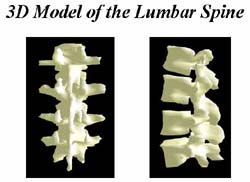Moving X-rays to revolutionise the diagnosis of back pain

A ’solid model’ of the human lumbar spine
A new image processing system devised by engineers at the University of Southampton could change the way that back problems are diagnosed and provide a solution to one of the most common causes of work loss in the UK.
Low back pain is a significant problem and its cost to society is enormous. However, diagnosis of the underlying causes remains problematic despite extensive study. Reasons for this arise from the deep-rooted situation of the spine and also from its structural complexity.
Professor Robert Allen and his team in the Signal Processing & Control Group in the University’s Institute of Sound & Vibration Research are working with colleagues at the University’s Electronics & Computer Science department, The Anglo-European College of Chiropractic, and Salisbury Hospital, to develop a way of X-raying individuals while they are moving, a technique which they believe will improve the diagnosis of back problems by enabling clinicians to quantify how the spine is moving.
‘Up to now, clinicians have frequently used plain X-rays to diagnose back problems,’ comments Professor Allen. ‘These X-rays can only tell you about the spine in a static position, but if we X-ray as the person moves using very low dose radiation, we can see how the spine is moving and with image processing techniques, we can quantify the movement. Since back pain is often caused by soft tissue damage and not damage to the bones themselves, abnormal motion of the vertebrae may help us to locate the source of the problem.’
Their approach is based on automatically identifying vertebrae from the motion image sequences, calculating how each vertebrae moves and coupling this information with a dynamic 3-D lumbar spine visualisation. The traditional approach has been for clinicians to take 2-D images and to form a 3-D impression by mentally transforming these images. Three-dimensional visualisation of the lumbar spine can allow clinicians to observe the lumbar spine from different viewpoints and angles and may be helpful in understanding, diagnosing and treating back pain problems.
Their next challenge is to establish what ‘normal’ movement looks like so that they are in a position to recognise abnormalities.
Media Contact
All latest news from the category: Health and Medicine
This subject area encompasses research and studies in the field of human medicine.
Among the wide-ranging list of topics covered here are anesthesiology, anatomy, surgery, human genetics, hygiene and environmental medicine, internal medicine, neurology, pharmacology, physiology, urology and dental medicine.
Newest articles

Machine learning algorithm reveals long-theorized glass phase in crystal
Scientists have found evidence of an elusive, glassy phase of matter that emerges when a crystal’s perfect internal pattern is disrupted. X-ray technology and machine learning converge to shed light…

Mapping plant functional diversity from space
HKU ecologists revolutionize ecosystem monitoring with novel field-satellite integration. An international team of researchers, led by Professor Jin WU from the School of Biological Sciences at The University of Hong…

Inverters with constant full load capability
…enable an increase in the performance of electric drives. Overheating components significantly limit the performance of drivetrains in electric vehicles. Inverters in particular are subject to a high thermal load,…





















